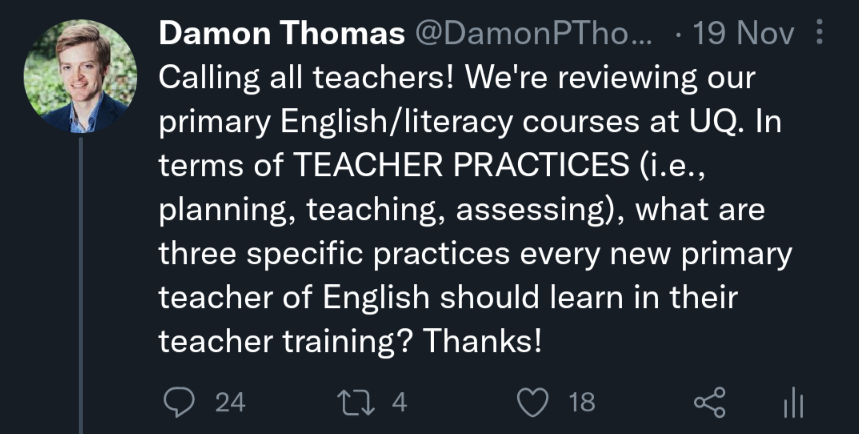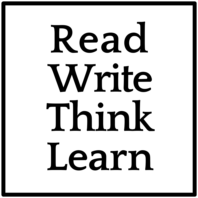
This post outlines my initial design of a new, 13-week early reading course that will be completed by all BEd Primary and MTeach Primary initial teacher education (ITE) students at the University of Queensland (UQ).
In a recent post, I wrote about the opportunity for teacher educators to be transparent about their course (i.e., unit) design. Explaining what and how we teach, and seeking feedback from the wider education community, has the potential to support other teacher educators providing similar courses at other institutions, while also building confidence in how teacher educators prepare ITE students for careers in the classroom.
I’d like to invite you to be part of this kind of course design process at UQ for the new reading course.
My hope is that some of you will take me up on this offer and that this will improve how I prepare ITE students to plan for, teach, and assess reading in primary classrooms.
What helped me to design this initial outline
The new course’s design had four sources of inspiration: reading experts who have written about reading development and instruction from the science of reading perspective; the Australian Institute for Teaching and School Leadership (AITSL), the education community, and my previous teaching at the University of Tasmania (UTAS). I’ll briefly explain how they informed the course design before introducing the course’s key underpinning theories/concepts and weekly topics.
- Reading experts
In the past four years, I’ve spent a considerable amount of time skilling myself up in terms of my knowledge about reading development and instruction. This knowledge building had occurred, largely, through reading. Reading books by well-known cognitive scientists like Stanislas Dehaene, Maryanne Wolf, Daniel T. Willingham, and Mark Seidenberg helped me learn about the complexities and importance of reading development.
I’ve also engaged regularly with the scholarly literature on reading instruction from the likes of Castles, Rastle, and Nation; Beck and McKeown; Rasinski; Stainthorp; Ehri; Moats; Rupley; Snow; Oakley, Cain, and Elbro; and many more. New research papers about what works in the teaching of all elements of reading are published all the time, so keeping up with the evolving research landscape is important for every educator interested in teaching reading well.
Other reading experts are also having a major impact through the translation of reading research into practical guidance and training for teachers. It built my confidence to see that the topics covered by Pam Snow and Tanya Serry in their Science of language and reading introductory course were very similar to the sorts of topics I included in my teaching at UTAS. If you’re a teacher who never really learnt the ins and outs of reading development and key theories like the simple view of reading, Pam and Tanya’s courses are well worth the (very reasonable) price of admission.
Websites like Five from five and (FREE) professional learning offered through Think Forward Educators have also helped many teachers engage with and gain confidence in the teaching of reading from the SoR perspective. Many talented teachers and researchers are giving a great deal of time and energy to support others in this space for the sake of the children in today’s and tomorrow’s classrooms. With free resources and PL opportunities, every teacher has the opportunity to learn to teach reading effectively.
- AITSL
Due to changing accreditation standards (explained here), it’s likely that teacher education providers will soon be adding considerably more reading content into their programs. At universities like UQ, new 13-week courses on reading and reading instruction are being developed and introduced, which is brilliant for everyone involved. But since English education is a broad field, and since most teacher educators are not experts in every element of English and its teaching, there are lecturers out there who would not consider themselves as experts in reading instruction. Clearly, this is a problem when a key part of the job is preparing beginning teachers to teach reading.
To help all teacher educators meet the new accreditation standards, AITSL has published a lofty 166-page document outlining in detail the sorts of English education topics they believe should be included in teacher education programs. They have outlined:
- Sample program outlines, indicating several options for the flow of topics across multiple courses
- 32 detailed modules (e.g., Language development) with suggested program year levels (i.e., should it be in the first, second, third, or fourth year of a degree), descriptions of content, suggestions for tutorial activites, key learning outcomes, references to build teacher educators’ knowledge of module content, and resources that can be used with initial teacher education students to support their learning.
It’s quite amazing how much useful information is in this AITSL document. Even if a lecturer is not an expert in reading, the guidance offered here means every university should be providing a first-rate experience when preparing ITE students to teach reading. I actually think any educator interested in reading instruction would gain from looking through this document and reading some of the many excellent references it lists. Think of it as a cheat sheet for all things reading instruction.
- The education community
Recently, I posted the following question on Twitter:

Nearly 400 people interacted with this tweet and a very generous 24 took the time to share their thoughts. The wonderful Tina Daniel-Zitzlaff also reposted the question on her Facebook group, Reading Teachers Australia, and sent me the feedback since I’m not a Facebook user. On the whole, the responses highlighted the importance of: specific elements of reading not traditionally taught (well?) in teacher education; assessment and data literacy; and reading models/frameworks such as Scarborough’s Reading Rope. This was very helpful feedback, so thanks to those who shared their ideas and experiences.
- My previous teaching at the University of Tasmania
As a final source of inspiration, I’ve been teaching early reading instruction at UTAS since taking over the second core English course there in 2016 (prior to that I was coordinating the first core English course). At UTAS, I covered early reading and writing in one 13-week course, which I split into 7 weeks for reading and 6 weeks for writing.
With only 7 weeks, I had an initial overview of reading, followed by the five essential elements of reading, and a week on explicit reading instruction. While there were bits and pieces missing from this approach, it still allowed me to cover many important concepts and set me up well to prepare a full course for UQ.
Some points to bear in mind while looking at the new course design
- This is a 13-week course, so I have one extra week to either cover a current topic over two weeks OR add something new into the mix. Have I missed anything or should something be spread out?
- For each element of reading noted below, I will provide an introduction, key teaching practices, and key assessment practices.
- While many teacher education programs prepare ITE students to become early childhood educators, BEd and MTeach ITE students at UQ are all training to become primary school teachers.
Key underpinning theories/concepts
For this new course, the following theories and concepts will underpin the weekly content:
- The simple view of reading (Gough & Tumner, 1986)
- Scarborough’s reading rope (Scarborough, 2001)
- The dual route cascaded model (Coltheart et al., 2001)
- Rosenshine’s principles of explicit instruction (Rosenshine, 2012)
- Response to Intervention (e.g., Fuchs and Fuchs, 2006)
Without further ado, here is the initial plan of weekly content:
Weekly topics for new early reading course
1. Overview and history of reading and reading instruction
2. Explicit reading instruction
3. Oral language (introduction, teaching, assessment)
4. Phonological awareness (introduction, teaching, assessment)
5. Concepts of print and alphabet knowledge (introduction, teaching, assessment)
6. Phonics (introduction, teaching, assessment)
7. Comprehension (introduction, teaching, assessment)
8. Vocabulary (introduction, teaching, assessment)
9. Fluency (introduction, teaching, assessment)
10. Supporting all readers
11. Links between reading and spelling
12. Course reflection: Managing the elements of reading
13. ?
How you can help inform the design and refinement of this reading course
At this stage, I’m looking for feedback from teachers and other education professionals about: (1) the selected underpinning theories/concepts, (2) the general flow of weekly topics, and (3) whether I should cover a current topic over two weeks or introduce another topic for the 13th week (the topic can be slotted in at any point in the course).
If you have any thoughts to share, you are most welcome to leave a comment below or reply to my initial tweet promoting this post on Twitter.
What’s next?
With key theories and weekly topics outlined, the next step will be designing the assessment tasks that will provide ITE students with opportunities to demonstrate their understandings of reading concepts and how to plan for, teach, and assess reading in classroom contexts.
Thank you to those who support me in designing (what I hope will be) a first-rate experience for ITE students at UQ. If any other teacher educators are currently designing or fleshing out reading-focused courses, I would like to support you in that process. Please reach out via Twitter or email and let’s talk about it (damon.thomas@uq.edu.au).
References
Coltheart, M., Rastle, K., Perry, C., Langdon, R., & Ziegler, J. (2001). DRC: a dual route cascaded model of visual word recognition and reading aloud. Psychological Review, 108(1), 204-56 https://www.doi.org/10.1037/0033-295x.108.1.204
Fuchs, D., & Fuchs, L. S. (2006). Introduction to Response to Intervention: What, why, and how valid is it? Reading Research Quarterly, 41(1), 93–99. https://doi.org/10.1598/RRQ.41.1.4
Gough, P. B., & Tunmer, W. E. (1986). Decoding, reading, and reading disability. Remedial and Special Education, 7, 6-10. http://dx.doi.org/10.1177/074193258600700104
Rosenshine, B. (2012). Principles of instruction: Research-based strategies that all teachers should know. American Educator, Spring 2012, 12-39. https://www.aft.org/sites/default/files/periodicals/Rosenshine.pdf
Scarborough, H. S. (2001). Connecting early language and literacy to later reading (dis)abilities: Evidence, theory, and practice. In S. Neuman & D. Dickinson (Eds.), Handbook for research in early literacy (pp. 97–110). Guilford Press.

I think your final topic could be how all the listed components or subskills interact with each other and cannot be taught as separate silo skills. Vocabulary impacts on comprehension, phonic knowledge and PA impacts on fluency, etc. The importance of embedding phonics into PA instruction etc.
Great thoughts here, Katrina! I will talk about how the various elements interact in the final week (currently point 12). It’ll be a reflection of the course but also a ‘threading together’ of the various elements. Something that might work well in that final week would be a focus on planning and programming that answers questions like, how do you set up a classroom for reading lessons, how to manage your time and the various elements, how to plan learning experiences that involve multiple reading elements, how to think of reading instruction as a cycle of planning, teaching, assessing, reflecting, and so on. Thanks for these thought-provoking ideas!
Hi Damon
I love your posts and wonder how we haven’t met yet. I’m in Darwin, currently redesigning my first year teaching placement unit: pure pedagogy. My background is early literacy though, which is why I write. I think you’ve got it all covered! Have you thought about HOW to maximise your excellent content?
In my unit, I’ve decided to dedicate a week “zero” to preparing for learning: providing an assessment exemplar (Or maybe the Reading Rope), organising study groups and proving an SFL-style teaching and learning cycle visual to explain how the content flows iteratively each week (broken up into: INDIVIDUAL jobs like reading and reflecting; GROUP tasks for de/co-construction; WHOLE CLASS etc), as first years I’m even suggesting how they should routinise their 10 hours/week asap. I’m mentioning this as I find that it’s the non-content stuff which is tricky in a first year undergrad and I know you are interested in making learning visible…
Sarah
Hi Sarah. It’s great to meet you! I really like your ideas here. I think it’s important to present ‘reading instruction’ as a cohesive idea at the start, then break it down into its components, then bring it back together at the end (like what Katrina suggested). Talking about the assessment tasks early is also important, and ensuring the ITE students know that what they’re doing for the assessments (and weekly tutorial tasks and readings) replicates the same sorts of things they’ll be doing as classroom teachers. I like your idea of using the TLC as a framework for showing how the course would broadly gradually transition from my teaching to collaborative learning, to independent learning, but also to suggest that this happens in smaller cycles throughout the course with the weekly content on each topic. I don’t think this will be a first-year course, but it definitely pays to be transparent with the students about how and why the course is designed in particular ways, and also how they can successfully develop the knowledge and skills about reading instruction that will set them up for teaching success (and to do well on the uni assignments as a byproduct). I appreciate you writing this comment; it’s made me think beyond the content to how I might structure and present it to the ITE students. My next job will be focusing on assessment tasks; feel free to chip in any other pearls of wisdom! Thanks again and good luck with your work in Darwin.
Hello Damon
Your post is so exciting to read and
I only wish I had met a Uni lecturer with your approach and knowledge.
I teach ESL and Primary literacy K-2Early Literacy then of course Reading to Learn 3-6
However all the courses I’ve done at Uni (Macq Uni) Sydney or Seminars don’t explain the following points I still struggle to figure out .
1 – Letter knowledge is different to Auditory knowledge both are critical
To learning Phonics
2- However once the child learns the Sound of a letter say /b/ what process do u recommend for teaching blending of sounds such as /b/ and /a/ makes /ba/ and so on . Do we assume this is a natural process? A visual process or the integration of Visual and Auditory? I have taught Phonics to ESL children for the last 3 years and sometimes it’s smooth and other times I wonder what the current research states?
There are a few theories just wondering what you think .
Many thanks
Carolina H
Dip Ed Primary
Post Grad Literacy
And am still questioning the process!!!
Hi Carolina. Thanks for your encouraging comment. I have some thoughts about your question, but I’d like to post it on Twitter first and see what the many reading experts there have to say. Hang in there and I’ll let you know what they say about the latest research. All the very best!